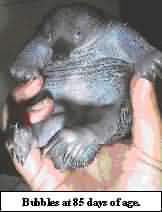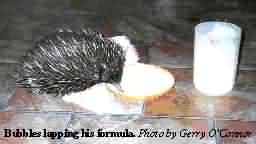CASE HISTORY:BUBBLES
 My 4 acres is fenced and Bubbles came home a couple of times a week and was always around the
house on a Saturday, which was feed day.
My 4 acres is fenced and Bubbles came home a couple of times a week and was always around the
house on a Saturday, which was feed day.
Bubbles was eight months of age and coming home for formula once every seven days and weighed
2•75 kilos. He resided under a pile of rocks in amongst a grove of trees and at other times
could be found foraging in his favourite spots on the property.
He levelled off with his requirement for milk and was lapping 600ml of formula at his weekly feed.
During the week between feeds, he lost approximately 200grams of weight which was used in energy
whilst foraging.
He gained 500gram after his feed of 500ml of formula. (Of course if the animal hasn’t got a
large foraging area, it could expend less energy in this time, and therefore lose less weight
between feeds.)
As we have not been able to collect data on the hand rearing of echidnas in northern QLD., we
allowed Bubbles to take what he wanted in formula since he began to lap from a dish. We would
give him more if he wanted it and he would leave milk when he was satisfied.
We feel that this method has proven successful, the result being an animal which looks as good
as those we encounter in the wild. This seems to be the only way to ensure was getting what he
required and we allowed him to dictate just what that was. We believe that if using Wombaroo
echidna formula, the animal will wean itself when its intake of solid food is sufficient to
not rely on the supplement milk offered.
I have come to the conclusion that ‘Eckles’, another echidna reared from spineless, was a
female, as she was lapping exactly half the amount of milk once per week, at 250 mls with her
weighing 2kg. She was not as friendly as Bubbles and did not follow me around the property so I
would take her out foraging every afternoon late until dark, then ensured she had at least half
a termite mound in her enclosure.
Eckles was released where she was initially found and Bubbles released himself from my property.
(unfortunately, Bubbles was found by some people and given to the local wildlife park who
released
him at their property, so I never got to see if Bubbles would continually return home)
PERSONALITY:
They are intelligent little creatures, and although it is difficult for marsupial carers to come
to terms with only handling the animal at feed times, you will still get attached, as they do
have
a personality and have their own way of interacting with you. Observing them is an extremely
interesting past time. They are very strong, and will try to push even you out of the way!
Bubbles made holes in the screen doors and it was not an uncommon event to find him in the office
curled up in a corner. If a door was left open, chances were that Bubbles would invite himself
in, so the golden rule around this place was to ensure that doors were not left open and if you
couldn’t find Bubbles in the bush, you started looking for him indoors!
WATER:
 Always have water available. A bowl placed in a hole in the ground is ideal, otherwise the
animal may tip it over if above the ground.
Always have water available. A bowl placed in a hole in the ground is ideal, otherwise the
animal may tip it over if above the ground.
SEX DETERMINATION:
An echidna’s sex cannot be determined without a probe, which is inserted into the vent to
determine gender, although if you are fortunate enough to have males and females to compare,
the stomach area where a pouch will eventually evolve is different to the male. The male only
has muscles in that region whereas the female has an indentation.
Apparently, an adult can weigh anywhere between 2 and 7 kilos.
WEANING:
After about 6-7 months, you would expect the echidna to weigh approximately 2 to 2 1/2 kilo.
At this stage, the animal will lose about 200 grams in between feeds, which is the energy that
it uses for foraging during the week. At this stage it should also be foraging for ants,
termites, invertebrates, earthworms, beetles, and larvae. They should wean from their milk
between 7 and 8 months of age.
Copyright © 2003 Lynda Staker -
Taken from Lynda Staker's book "Don't Step Backwards"
Back to Echidna index
Back to FRW Home page
 My 4 acres is fenced and Bubbles came home a couple of times a week and was always around the
house on a Saturday, which was feed day.
My 4 acres is fenced and Bubbles came home a couple of times a week and was always around the
house on a Saturday, which was feed day. Always have water available. A bowl placed in a hole in the ground is ideal, otherwise the
animal may tip it over if above the ground.
Always have water available. A bowl placed in a hole in the ground is ideal, otherwise the
animal may tip it over if above the ground.